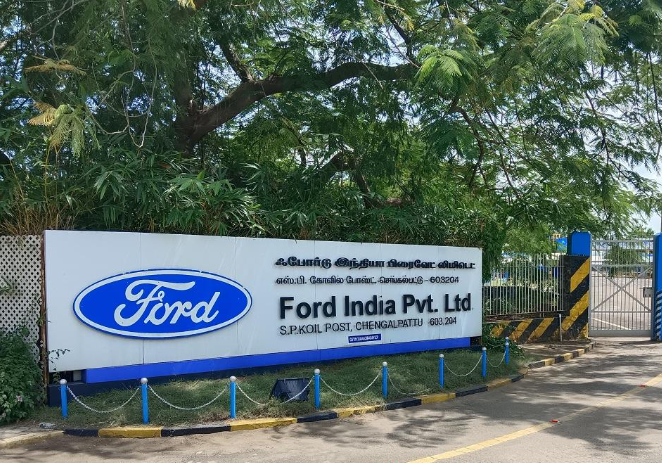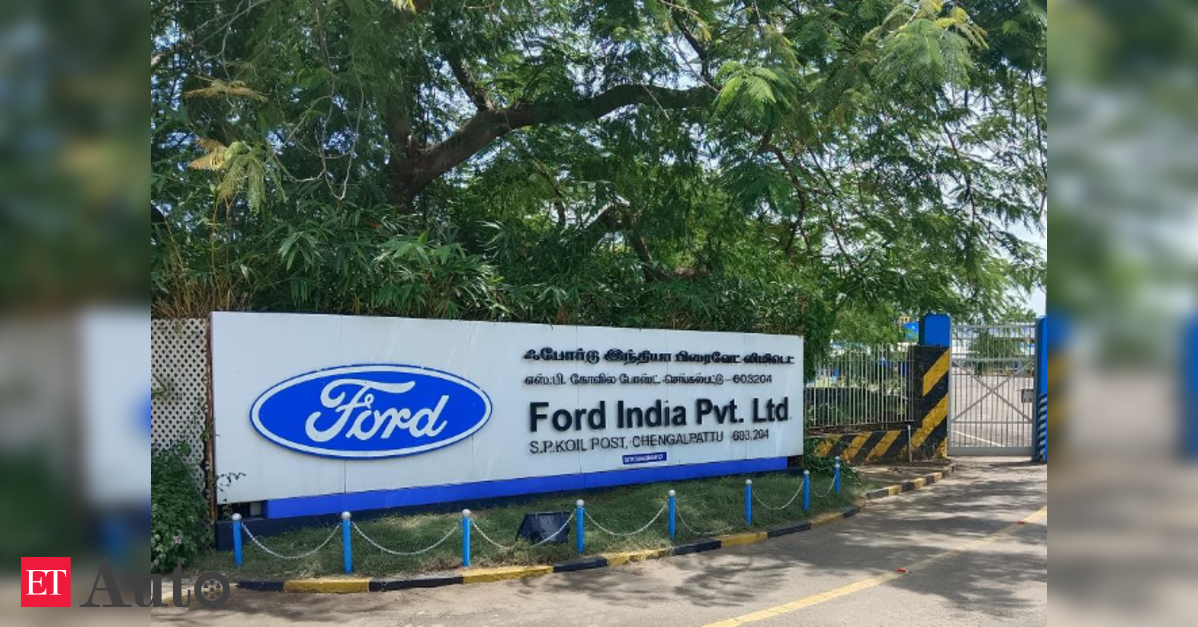 Ford suddenly changed its mind about selling the facility and announced that it would resume operations there.
Ford suddenly changed its mind about selling the facility and announced that it would resume operations there.Ford Motor Company has finally unveiled its business plans for India in its second innings, which will see engines being produced at its Maraimalai Nagar plant near Chennai beginning in 2029.
It is still unclear what Donald Trump has to say about Ford’s move to restart operations in India, even though it will not be accompanied by the glamour of fancy cars but by a more sober landscape where new-generation engines will be shipped out of Chennai to different parts of the world.
The American President has been quite vocal about his difficult relationship with India, which has led to a massive 50 per cent tariff on goods imported from the country.
Yet, Trump has also been blowing hot and cold with India, where he is all praise one moment and absolutely exasperated on other occasions. Given these extreme mood swings, it is interesting why he has still not reacted to Ford’s decision to use India as an engine manufacturing hub.
Two other prominent American auto brands, General Motors and Harley-Davidson, have already shut down their manufacturing operations in this part of the world. Ford also followed suit five years ago, selling its Gujarat plant to Tata Motors, while the one near Chennai was also set to change hands, with industry grapevine suggesting the JSW group being a contender.
Victory of sorts
Ford suddenly changed its mind about selling the facility and announced that it would resume operations there. This was seen as a huge victory of sorts for the Tamil Nadu government, which had achieved the impossible by persuading a top multinational in exit mode to change its mind and stay.
While this was happening, Trump had begun his second term as US President with a fusillade of tariff announcements worldwide. His underlying MAGA (Make America Great Again) message was to have more investments flowing into the US rather than the other way around.
In this context, it would have been unrealistic to persuade Ford to commit to its India plan, but the unexpected has happened: the company has announced new investments even while cars are not part of the revised blueprint.
Within industry circles, people wonder what Ford plans to do with its engines, which will total 235,000 units annually in Chennai at an investment of over ₹3,000 crore. The US remains its major market, followed by Europe, while other regions like Latin America and China are little to write home about. Africa and ASEAN are almost negligible too, as Ford markets, and it will be interesting to see where these engines will eventually head out to.
A section of industry observers believes that Europe will be the most preferred destination. “There are obvious labour cost advantages emanating out of India while import duty levies on engines coming into Europe are not so high either,” said a top-level executive.
According to him, shipping these engines to the US would make little sense given the long distance and associated freight and logistics costs.
The strategy going forward
“Perhaps Ford plans to build its presence in Asia-Pacific where it will then use India as a strategic hub for engines. The supplier base here is top-class with an extremely competitive costing structure. Eventually, ASEAN and Europe can be serviced out of India by the end of this decade,” added the executive.
Incidentally, Ford shipped engines from its Gujarat plant, which was sold to Tata Motors as part of its exit route from India.
The American automaker has had a virtual rollercoaster ride in India since the time it set up operations at an all-new facility in Chennai nearly 25 years ago.
Prior to this, it was retailing a limited number of its Escort model through its local partner, Mahindra & Mahindra’s facility in Nashik. Ford had a successful debut model with the Ikon from Chennai, but could not sustain the momentum thereafter, as competitors like Maruti and Hyundai raced ahead.
Yet, there were offerings like the Endeavor and EcoSport, which caught the fancy of the market but did little in terms of creating economies of scale at the Chennai facility.
The company also tried hard to enter the small-car space with Figo, but the Big Bang effect remained elusive. Perhaps this had to do with issues at the retail end, or just not being able to cope with the super-aggression levels of the Japanese and Koreans led by Maruti and Hyundai.
Yet Ford continued to fight it out, even as it was evident that sustaining operations with an additional plant in Gujarat was becoming more difficult. The company was keen to make India part of its ‘One Ford’ plan, conceived by its former President & CEO, Alan Mulally, who served from 2006 to 2014. This initiative was intended to prune the number of global platforms and increase the commonality of components.
Centre of the market
In a 2012 interview with this writer, Mulally had said that India was important to the company since the products made here, like the “Figos, Fiestas or small SUVs”, were the centre of the market worldwide.
“That is why you see us making such a focused investment in balancing our portfolio to have an increasing number of smaller and medium-size vehicles,” he added.
According to Mulally, smaller vehicles accounted for nearly 60 per cent of worldwide requirements and would be part of Ford’s global platforms. Here, 70-80 per cent of the components would be exactly the same across the chain.
“We will actually make vehicles in the same way across the world. A Fiesta in Chennai will be made exactly the same way as in China or the US which gives us the scale with our suppliers and [helps us] bring more affordable products (than competition) to customers,” said Mulally in the interview.
Jim Farley, who is now President & CEO of Ford, echoed these sentiments at a roundtable in Mumbai when the American automaker announced its alliance with former Indian ally M&M in 2019. At that point in time, he was President of Ford New Businesses and had this to say: “We learnt a lot from ‘One Ford’ and I mean a lot.”
Fusion of capabilities
The team at Ford understood that the scale had to be local to get value. If the product attributes were ‘over attributed’ with global, and not local scale, things could not quite work from the viewpoint of value creation.
This, according to Farley, was a very important lesson for Ford as it went about the plan and redesigned its business.
“We will have a fusion of a new capability below which is a local scale and that is really the opportunity we have with M&M,” he said.
The other opportunity, which again was “a good part” of ‘One Ford’, was learning how to export from India. “If you go to anyone who owns an EcoSport in Western Europe, Germany or Chicago, they love the product,” said Farley while driving home the point of global competencies developed locally.
It was testimony to India’s quality, and there was no doubt that this product was truly world-class.
“We believe that this was an important positive lesson from One Ford. Now we get to do it with a cost base that we have never had before (with M&M),” he added.
As luck would have it, the alliance with M&M never took off, thanks in large part to the 2020 pandemic, which had the world in a state of near paralysis.
Till then, the partners were upbeat about the road ahead, with Farley reiterating at the Mumbai roundtable that the Indian market had changed a great deal over the years, with emerging markets becoming important for Ford.
He said the marriage this time around with M&M had a different objective, which was to “develop new products, use M&M’s incredible capabilities that they have built since our last JV and now to benefit from that being together both in India and overseas”.
Pulling out of unviable markets
The alliance was shelved following Ford’s decision to pull out of India. It subsequently announced in 2021 that it was exiting the Brazilian market, too, meaning that all its energy would be focused largely on the US and Europe.
The return to India marks an interesting reversal of Ford’s earlier intent to exit most unviable markets. It still has a robust backend operation in Chennai — Ford Business Solutions — which caters to functions such as software engineering, analytics, data science, etc., and has on board nearly 15,000 engineers.
Now that engines are scheduled to be manufactured near Chennai, it pretty much sums up the company’s priorities in leveraging India’s competencies, both in manufacturing and services. How the script pans out eventually will be interesting to see.



